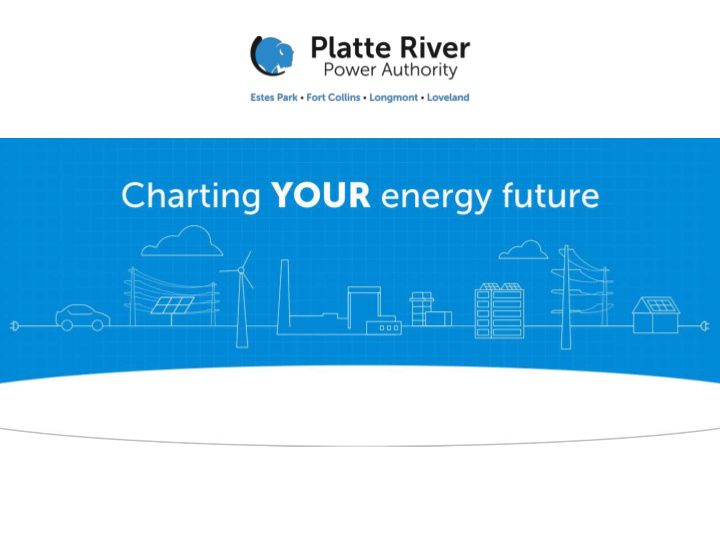



Objective Educate, engage and listen to the citizens of our four owner communities regarding Platte River’s energy future. • Provide history and information about Platte River Power Authority • Share information about the integrated resource plan (IRP) • Seek your input
Community listening sessions Fort Collins, October 25 from 6-9 p.m. Hilton Fort Collins Estes Park, November 1 from 6-9 p.m. Estes Park Town Hall, council chambers Longmont, November 5 from 6-9 p.m. Longmont Museum, Stewart Auditorium Loveland, November 15 from 6-9 p.m. Embassy Suites, Canyon Maple C
Agenda Presentation • Jason Frisbie, general manager/CEO • About Platte River • Andy Butcher, chief operating officer • Integrated resource planning process • Brad Decker, resource planning manager • Integrated resource planning studies • Alyssa Clemsen Roberts, chief strategy officer • Survey • Open for discussion and questions Panelists • Dave Smalley, Platte River deputy GM/CFO • Reuben Bergsten, Estes Park director of utilities
Jason Frisbie General manager/CEO
Platte River Power Authority Platte River Power Authority is a not-for-profit wholesale electricity generation and transmission provider that delivers safe, reliable, environmentally responsible, and competitively priced energy and services to its owner communities of Estes Park, Fort Collins, Longmont and Loveland for delivery to their utility customers.
Generation timeline
Generation timeline
Generation timeline
Generation timeline
Planned generation
Current generation resources Rawhide Rawhide Units Federal Rawhide Unit 1 A, B, C, D, F Hydropower Solar Flats Coal Natural Gas Solar Hydropower 388 MW 280 MW 90 MW 30 MW Medicine Bow Silver Sage Spring Canyon Craig Units Wind Project Wind Project Wind Center 1 & 2 Wind Wind Wind Coal 6 MW 12 MW 60 MW 154 MW
2018 projected deliveries 2% 1% 5% 2.2% 11% Coal Hydro Wind Purchases 19% Solar 62% Natural gas Approx. 32% non carbon
Planned generation resources Roundhouse Renewable Community Solar Solar Energy Project 20 MW Wind 150 MW
2021 projected deliveries 1% 1% 3% 19% Coal Wind Hydro 48% Solar Purchases Natural gas 28% Approx. 50% non carbon
Core pillars Platte River is committed to: • System reliability • Financial sustainability • Environmental responsibility
Integrated resource planning process Andy Butcher, chief operating officer
What is an integrated resource plan (IRP)? • Immediate and long term action plan to meet future energy goals • Assists with preparing for industry changes including: technological progress, consumer preferences and regulatory mandates • Required by Western Area Power Administration (WAPA) every 5 years • Last submitted in 2016
Why an IRP now? Much has changed since Platte River’s last IRP • Business changes • Technology advancements • Industry changes • Added more renewable assets • Increased community interest • Owner communities' goals
IRP objectives • Evaluate a full range of resource paths, from current resource mix to 100% renewable energy • Model the impact of additional renewable resources, distributed energy, conservation, energy storage and demand response potential • Consider ways to reduce reliance on coal and/or defer the need for natural gas resources • Conduct extensive outreach to gain community perspectives
IRP process Listen to public’s long term expectations – through surveys, 1. stakeholder meetings, city council meetings and multiple rounds of community listening sessions 2. Develop supporting studies 3. Operational and financial analysis of IRP portfolio types (modeling matrix) 4. Present to board for approval 5. Submit to WAPA for approval 6. Plan adopted
IRP timeline
IRP timeline
IRP timeline
Integrated resource planning studies Brad Decker, resource planning manager
Market analysis Primary inputs for resource modeling – to be completed by Pace Global • Regional market power prices • Regional market fuel prices • Projections for the future carbon costs • Costs for future generation resources
Generation and technology review A high-level look at potential resource and technology options for the IRP – to be completed by Pace Global • Evaluates resource and technology options based on cost, performance and commercial viability • Reviews Platte River’s existing resource portfolio
Coal cycling study Primary source of resource modeling inputs – to be completed by Burns & McDonnell • Evaluates the cost and performance impacts on coal plants from increasing amounts of renewable generation • Determines fixed and variable cost impacts arising from higher renewables • Identifies impacts on plant reliability and efficiency
Resource adequacy study Analyzes changes to Platte River’s future resource needs – to be completed by Burns & McDonnell • Evaluate system reliability and reserve margin requirements • Aurora models will analyze energy needs during emergency, contingency and curtailment events
Efficiency and demand side management potential Evaluates potential for demand side management (DSM) and distributed technologies – to be completed by HDR • Study the potential across different customer groups • Review a range of avoided resource costs • Focus on distributed technologies • Distributed generation and storage • Electric vehicles • Energy efficiency
Thermal resources cost study Provides primary inputs for modeling natural gas resource options - to be completed by HDR • Performance, operating costs, construction costs and emission estimates for various natural gas generation types
Energy storage analysis • Evaluate cost and performance for a variety of energy storage options – to be completed by HDR • Batteries • Pumped hydro • Compressed air
Regional economic analysis Evaluation of impacts to regional economy from potential changes in electricity rates – to be completed by Colorado State University • Unemployment • Wages • Regional production – dollar value of goods and services • Consumer prices
Generation technology life cycle study Determine environmental impacts of future energy resources; this study will be submitted for academic peer review – to be completed by Colorado State University • Greenhouse gas emissions • Landfill impacts • Use of natural resources
Survey Alyssa Clemsen Roberts, chief strategy officer
Summary, next steps • Just getting started • Long, complex process • Community engagement will continue through the resource planning process • Survey – and your input
Open forum questions and comments
Recommend
More recommend